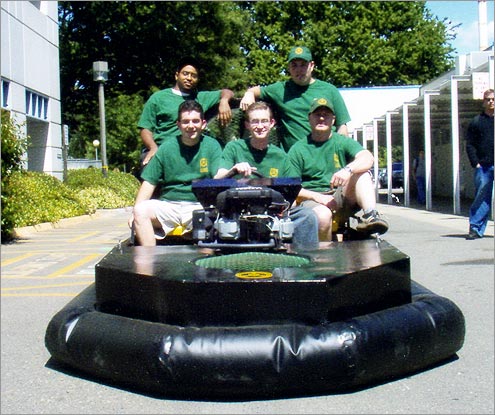Hover Hornet Hovercraft

The CSU Sacramento's Department of Mechanical Engineering designed and completed the Hover Hornet multi-passenger hovercraft as their senior project. The team used TAP's X-30 Polyurethane Foam as the main component of the project. Below is an excerpt from their report explaining how they used the foam:
"Since the frame has floor support members that are spaced at the most 16", they are not evenly spaced; the plywood thickness was figured to be 3/4" to withstand the load of the passengers, payload, and a pilot. Once the team decided to put expandable foam in the hull, the thickness of the plywood was reduced to 5/8". The design incorporates expandable polyurethane foam in the hull. The foams come in a 2 part liquid mixture and expand to 30 times its liquid volume. Putting the foam in the hull will stiffen the hovercraft and add buoyancy in the case of marine use. The foam should float 60 lbs. Per cubic foot. Design analysis was limited to researching expandable foam through TAP Plastics. Once the information was obtained from available materials, the team calculated the volume that could be filled on the hovercraft. The foam expands 30 times its liquid volume. So, 2 gallons will fill approximately eight cubic feet, which will float 460 lbs."
"Since the frame has floor support members that are spaced at the most 16", they are not evenly spaced; the plywood thickness was figured to be 3/4" to withstand the load of the passengers, payload, and a pilot. Once the team decided to put expandable foam in the hull, the thickness of the plywood was reduced to 5/8". The design incorporates expandable polyurethane foam in the hull. The foams come in a 2 part liquid mixture and expand to 30 times its liquid volume. Putting the foam in the hull will stiffen the hovercraft and add buoyancy in the case of marine use. The foam should float 60 lbs. Per cubic foot. Design analysis was limited to researching expandable foam through TAP Plastics. Once the information was obtained from available materials, the team calculated the volume that could be filled on the hovercraft. The foam expands 30 times its liquid volume. So, 2 gallons will fill approximately eight cubic feet, which will float 460 lbs."


